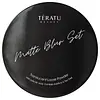Teratu Beauty Matte Blur Set Translucent Loose Powder Versus Somethinc Hooman Under Control HD Blur Loose Powder
What's inside
What's inside
 Key Ingredients
Key Ingredients

 Benefits
Benefits

 Concerns
Concerns

 Ingredients Side-by-side
Ingredients Side-by-side

Talc
AbrasiveAluminum Starch Octenylsuccinate
AbsorbentMethyl Methacrylate Crosspolymer
Hydrated Silica
AbrasiveNylon-12
Diisostearyl Malate
EmollientIsononyl Isononanoate
EmollientSqualane
EmollientPhenoxyethanol
PreservativeCI 77891
Cosmetic ColorantSalicylic Acid
MaskingTocopheryl Acetate
AntioxidantGlycerin
HumectantCI 77492
Cosmetic ColorantButylene Glycol
HumectantEthylhexylglycerin
Skin ConditioningMelaleuca Alternifolia Leaf Oil
AntioxidantWater
Skin ConditioningCI 77491
Cosmetic ColorantCentella Asiatica Leaf Extract
Skin ConditioningRice Bran/Germ Triterpenoids
Skin ConditioningBioflavonoids
Skin ConditioningSesame Amino Acids
HumectantCI 77499
Cosmetic ColorantAluminum Hydroxide
EmollientHydrogen Dimethicone
Triethoxycaprylylsilane
Talc, Aluminum Starch Octenylsuccinate, Methyl Methacrylate Crosspolymer, Hydrated Silica, Nylon-12, Diisostearyl Malate, Isononyl Isononanoate, Squalane, Phenoxyethanol, CI 77891, Salicylic Acid, Tocopheryl Acetate, Glycerin, CI 77492, Butylene Glycol, Ethylhexylglycerin, Melaleuca Alternifolia Leaf Oil, Water, CI 77491, Centella Asiatica Leaf Extract, Rice Bran/Germ Triterpenoids, Bioflavonoids, Sesame Amino Acids, CI 77499, Aluminum Hydroxide, Hydrogen Dimethicone, Triethoxycaprylylsilane
Talc
AbrasiveAluminum Starch Octenylsuccinate
AbsorbentBoron Nitride
AbsorbentSilica
AbrasiveNylon-12
Zea Mays Starch
AbsorbentMagnesium Myristate
Caprylyl Glycol
EmollientEthylhexylglycerin
Skin ConditioningDimethicone
EmollientTriethoxycaprylylsilane
Hydrogen Dimethicone
Methicone
EmollientMacadamia Ternifolia Seed Oil
EmollientTocopherol
AntioxidantMica
Cosmetic ColorantCI 77492
Cosmetic ColorantCI 77491
Cosmetic ColorantCI 77499
Cosmetic Colorant
 Reviews
Reviews

Ingredients Explained
These ingredients are found in both products.
Ingredients higher up in an ingredient list are typically present in a larger amount.
Aluminum Starch Octenylsuccinate is a synthetic powder used as an absorbent, thickener, and anti-caking agent.
As an absorbent, it is great at mattifying skin by soaking up the oil. This is why you'll find it in a range of products from makeup to moisturizers.
This ingredient is considered a modified starch. Starch can also be found naturally in plants.
One study from 1991 found that 5% of this ingredient enhanced titanium dioxide SPF by as much as 40%. The study found 1% titanium dioxide had a 5.6 SPF and adding 5% of aluminum starch octenylsuccinate boosted it to an SPF of 8.1
Although “aluminum” in an ingredient name can raise red flags for some consumers, the form and usage context matter significantly. For typical topical applications, there is no substantial evidence of health risks - such as cancer, neurotoxicity, or systemic “aluminum overload.”
Learn more about Aluminum Starch OctenylsuccinateCi 77491 is also hydrated iron III oxide. It's sole purpose is to give a red/pink hue to products.
Iron III oxides are classified as inorganic chemicals for coloring.
Synthetically created Ci 77491 is considered safer than those naturally found. This is because the synthetically created version may contain less impurities. Iron oxides are generally non-toxic and non-allergenic.
Learn more about CI 77491Ci 77492 is also hydrated iron III oxide. It's sole purpose is to give a yellow hue to products.
Iron III oxides are classified as inorganic chemicals for coloring.
Synthetically created Ci 77492 is considered safer than those naturally found. This is because the synthetically created version may contain less impurities. Iron oxides are generally non-toxic and non-allergenic.
Learn more about CI 77492Ci 77499 is also hydrated iron III oxide. It is created from mixing red and black iron oxides. This helps give shades of darkness to a product.
Iron III oxides are classified as inorganic chemicals for coloring.
Ethylhexylglycerin (we can't pronounce this either) is commonly used as a preservative and skin softener. It is derived from glyceryl.
You might see Ethylhexylglycerin often paired with other preservatives such as phenoxyethanol. Ethylhexylglycerin has been found to increase the effectiveness of these other preservatives.
Hydrogen Dimethicone is a type of silicone.
Nylon-12 is a polymer. It is derived from 12-aminododecanoic acid, an omega-amino fatty acid
According to a manufacturer, it is a talc substitute. Like talc, nylon-12 gives products a satin feel. The manufacturer also claims this ingredients does not block pores and has moderate oil absorption.
This ingredient may not be reef-safe.
Learn more about Nylon-12Talc is a clay mineral. It helps absorb moisture and improve the texture of products. Like other types of clay, Talc can have a slight exfoliating effect on skin. Talc can be added to increase the volume of products.
Some Baby powders are made by combining talc with corn starch. The word "talc" comes from Latin and originates from Arabic. Talc is a mineral commonly found throughout the world.
If you have any concerns about using talc, we recommend checking out the FDA's official page.
Learn more about TalcTriethoxycaprylylsilane is a silicone used to bind and stabilize ingredients.
As an emulsifier, it helps prevent ingredients from separating. This can help elongate the shelf life of products.
Triethoxycaprylylsilane is often used to coat mineral sunscreens ingredients to help give a better feel. It also helps reduce oxidative stress in sunscreens.
Learn more about Triethoxycaprylylsilane